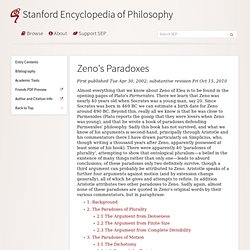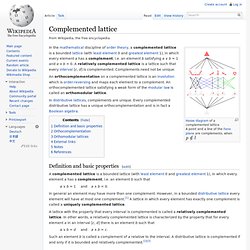

Zeno's Paradoxes. First published Tue Apr 30, 2002; substantive revision Fri Oct 15, 2010 Almost everything that we know about Zeno of Elea is to be found in the opening pages of Plato's Parmenides.

There we learn that Zeno was nearly 40 years old when Socrates was a young man, say 20. Since Socrates was born in 469 BC we can estimate a birth date for Zeno around 490 BC. Beyond this, really all we know is that he was close to Parmenides (Plato reports the gossip that they were lovers when Zeno was young), and that he wrote a book of paradoxes defending Parmenides' philosophy.
Sadly this book has not survived, and what we know of his arguments is second-hand, principally through Aristotle and his commentators (here I have drawn particularly on Simplicius, who, though writing a thousand years after Zeno, apparently possessed at least some of his book). 1. Before we look at the paradoxes themselves it will be useful to sketch some of their historical and logical significance. 2. Retículo (matemáticas) En matemáticas, un retículo es una determinada estructura algebraica con dos operaciones binarias, o bien un conjunto parcialmente ordenado con ciertas propiedades específicas (siendo equivalentes ambos enfoques).

El término "retículo" viene de la forma de los diagramas de Hasse de tales órdenes. Orthocomplemented lattice. Complemented lattice. Definition and basic properties[edit] A complemented lattice is a bounded lattice (with least element 0 and greatest element 1), in which every element a has a complement, i.e. an element b such that a ∨ b = 1 and a ∧ b = 0.

In general an element may have more than one complement. However, in a bounded distributive lattice every element will have at most one complement.[1] A lattice in which every element has exactly one complement is called a uniquely complemented lattice. A lattice with the property that every interval is complemented is called a relatively complemented lattice. A ∨ b = d and a ∧ b = c. Such an element b is called a complement of a relative to the interval. Orthocomplementation[edit] An orthocomplementation on a bounded lattice is a function that maps each element a to an "orthocomplement" a⊥ in such a way that the following axioms are satisfied: Complement law a⊥ ∨ a = 1 and a⊥ ∧ a = 0.
Involution law a⊥⊥ = a. Order-reversing if a ≤ b then b⊥ ≤ a⊥. Orthomodular lattices[edit]